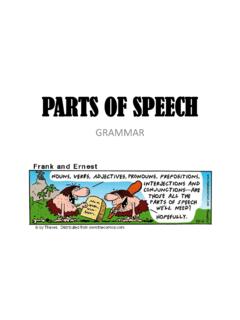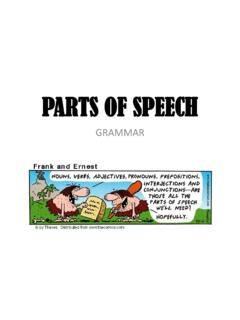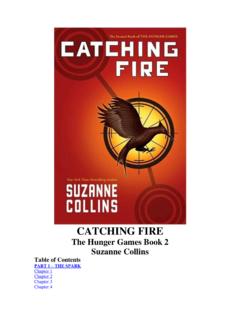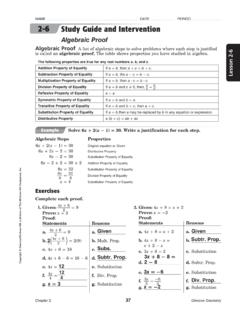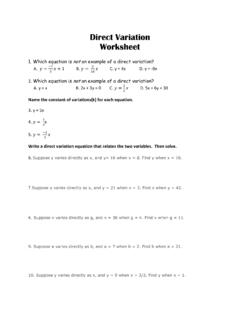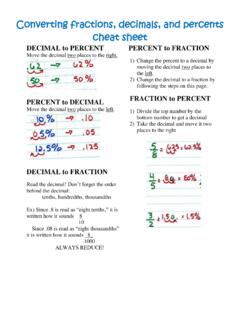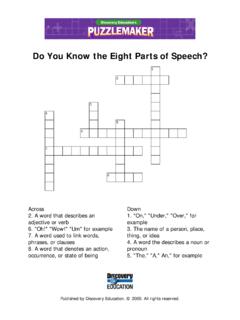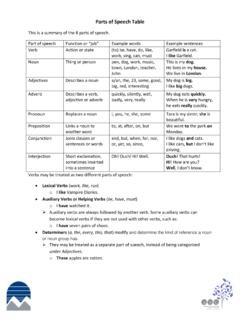Transcription of Eight Parts of Speech - Anderson School District Five
1 Eight Parts of Speech noun Pronoun Adjective Verb Adverb Preposition Interjection Conjunction noun . A noun is a word used to name a person, place, thing, or idea Types of Nouns Singular- a word used to name one person, place, thing, or idea Plural- a word used to name more than one person, place, thing, or idea Q: What is the easiest way to make a singular noun plural? A: Add an s or es to the end of it! Types of Nouns Proper- a word used to name a particular person, place, thing, or idea; this noun is usually capitalized Common- names any one of a group of persons, places, things, or ideas, and is not capitalized Types of Nouns Concrete- names an object that can be perceived by the senses (most likely is tangible). Abstract- names an idea, a feeling, a quality, or a characteristic (cannot be physically touched).
2 Types of Nouns Collective- names a group; although it contains individual members, it is identified as a singular noun . Compound- consists of two or more words used together as a single noun ; they may be written as one word, two or more words, or as a hyphenated word. Pronouns Pronouns- a word used in place of one or more nouns or pronouns Personal Pronouns Singular Plural First Person I, my, mine, me We, our, ours, us Second Person You, your, yours You, your, yours Third Person He, his, him, They, their, theirs, she, her, hers, them it, its Pronouns Reflexive Pronouns Singular Plural First Person Myself Ourselves Second Person Yourself Yourselves Third Person Himself, Themselves Herself, Itself There is no such word as hisself. The grammatically correct reflexive pronoun is himself.
3 Pronouns Interrogative Pronouns- used to begin questions Interrogative: who, whom, whose, which, what Demonstrative Pronouns- used to point out a specific person, place, thing, or idea Demonstrative: this, that, these, those Indefinite Pronouns- used to refer to people, places, things, or ideas in general;. frequently used without antecedents Indefinite: all, any, either, many, none, etc. Pronoun and Antecedent A pronoun usually refers to a noun that comes before it. This noun , called an antecedent, gives the pronoun its meaning. Example: Thomas closed his book and put it down. his refers to the antecedent Thomas ;. it refers to the antecedent book . Pronoun and Antecedent Pronouns and Antecedents must match in number. Example: The coach showed the players how they should throw the ball.
4 They refers to the antecedent players.. Since players is plural, the plural pronoun must be used. Pronoun and Antecedent A pronoun may appear in the same sentence as its antecedent or in a following sentence. Example: Have the birds flown south yet? They should start migrating soon. Example: Lee hit a home run. It was his first of the season. Adjectives Adjective- a word used to modify (describe or make more definite) a noun or pronoun Adjectives will answer at least one of the following FIVE questions: one? kind? many? much? Adjectives usually precede the words they modify (unlike other languages). Adjectives The most frequently used adjectives are called ARTICLES. Indefinite Articles are used for any general noun . They are A and AN.. Q: How do you know when to use A and when to use AN ?
5 A: Look at the word that follows and choose: A= word beginning with a consonant sound AN= word beginning with a vowel sound Adjectives Use the Definite Article THE to indicate someone or something in particular. Q: How do you know when to use THE , and not A and/or AN ? A: It can precede any word, regardless of the initial sound, but must indicate something in particular Verbs Verb- a word used to express an action or a state of being (a form of the word be ). ACTION VERBS- express physical or mental activity; it's what you do! There are two types of ACTION verbs: Transitive and Intransitive Types of Action Verbs Transitive Verbs- action verbs that express action directed toward a person or thing named in the sentence Example: Neil rang the bell. Intransitive Verbs- action verbs that express action without passing the action from a doer to a receiver Example: The children laughed.
6 Types of Verbs Linking Verbs- a verb that connects the subject to a word that identifies or describes it Example: The answer is three. Many linking verbs can be used as action (nonlinking) verbs as well. Example: The wet dog smelled horrible. The dog smelled the bread. Verb Phrases Verb phrases- consist of a main verb preceded by at least one helping verb (also known as an auxiliary verb). VP= HV + AV. All forms of the verb be are helping verbs: Am Are Were Being Is Was Be Been Helping Verbs Besides all forms of the verb be, helping verbs include: Have Do Shall Would Must Has Does Will May Can Had Did Should Might Could Most common forms of be Present: Singular Plural 1st person I am We are 2nd person You are You are 3rd person He/She/It is They are Past: Singular Plural 1st person I was We were 2nd person You were You were 3rd person He/She/It was They were Verb Tenses Present tense- there is no distinctive form by which it can be recognized, other than the e(s) ending used with 3rd person singular pronouns (he, she, it) or the noun for which a 3rd person singular pronoun can substitute Example: John looks terrific.
7 He The only two verbs irregular in 3rd person singular are be (is) and have (has). Verb Tenses Past tense- there are typically two main ways to form the past tenses, called regular and irregular Regular: formed by adding (e)d Dictionary form Past tense form Pass Passed Cough Coughed Smile Smiled Dread Dreaded Verb Tenses Irregular: do not add the (e)d ending but instead change the vowel of the dictionary form Dictionary form Past tense form Dig Dug Ring Rang Freeze Froze See Saw Run Ran Verb Tenses Caution: There are verbs with past tenses that are a mixture of regular and irregular forms, , they have both a vowel change and a regular ending (sell-sold). There is a group of verbs that have no distinct past tense form at all; the verbs in this group are single-syllable verbs that end in t or d; for example hit-hit; slit- slit; cut-cut; rid-rid; shed-shed.
8 Is it a VERB? Two very simple tests: 1. Recast the word in past tense. 2. Add will to form a future tense. Examples: Sentence: The children love New York. Past tense: The children loved New York. Will: The children will love New York. Sentence: Children love spinach. Past tense: Children love spinached. Will: Children love will spinach. Adverbs Adverb- a word used to modify a verb, an adjective, or another adverb Adverbs will answer at least one of the following FIVE questions: what extent? Adverbs Asking to what extent means how far, how often, and so on. Adverbs also have three forms to show comparison: Positive Comparative Superlative Big Bigger Biggest Fast Faster Fastest Late Later Latest Add er or more to form the comparative. Add est or most to form the superlative.
9 Adverbs The easiest way to recognize adverbs is to look for words ending in ly. Be careful; ask the five questions to double-check the word usage. If a word is normally considered a noun , but answers one of the five questions, it should be labeled as adverb. Adjectives and Adverbs Please remember, if you locate a word that modifies a noun or pronoun, it is an adjective. If you locate a word that modifies that adjective, it is considered an adverb (not another adjective). Adjective Adverb Nouns Verbs Pronouns Adjectives Adverbs Adverbs Some of the most common adverbs are: Quite Very Much Too Rather Not Never -n't Prepositions Preposition- a word used to show the relationship of a noun or pronoun to some other word(s) in the sentence A preposition ALWAYS introduces a phrase.
10 The noun or pronoun that ends the prepositional phrase is called the object of the preposition..(PREP ..N/PR) .. Prepositions Prepositions cannot stand alone! A prepositional phrase starts with a preposition and ends with the first noun or pronoun that follows that preposition. PLEASE NOTE: Some words on the list of prepositions may also be used as adverbs. Remember than an adverb is a modifier and does NOT take an object! Ask the adverb questions! Prepositions Please be cautious of compound prepositions. These are prepositions that are made up of several words, but counted as one preposition. EXAMPLES: as of today; in addition to the assignment; next to Fred; in spite of your objections; aside from that; in case of an accident, etc . Preposition or Adverb?
